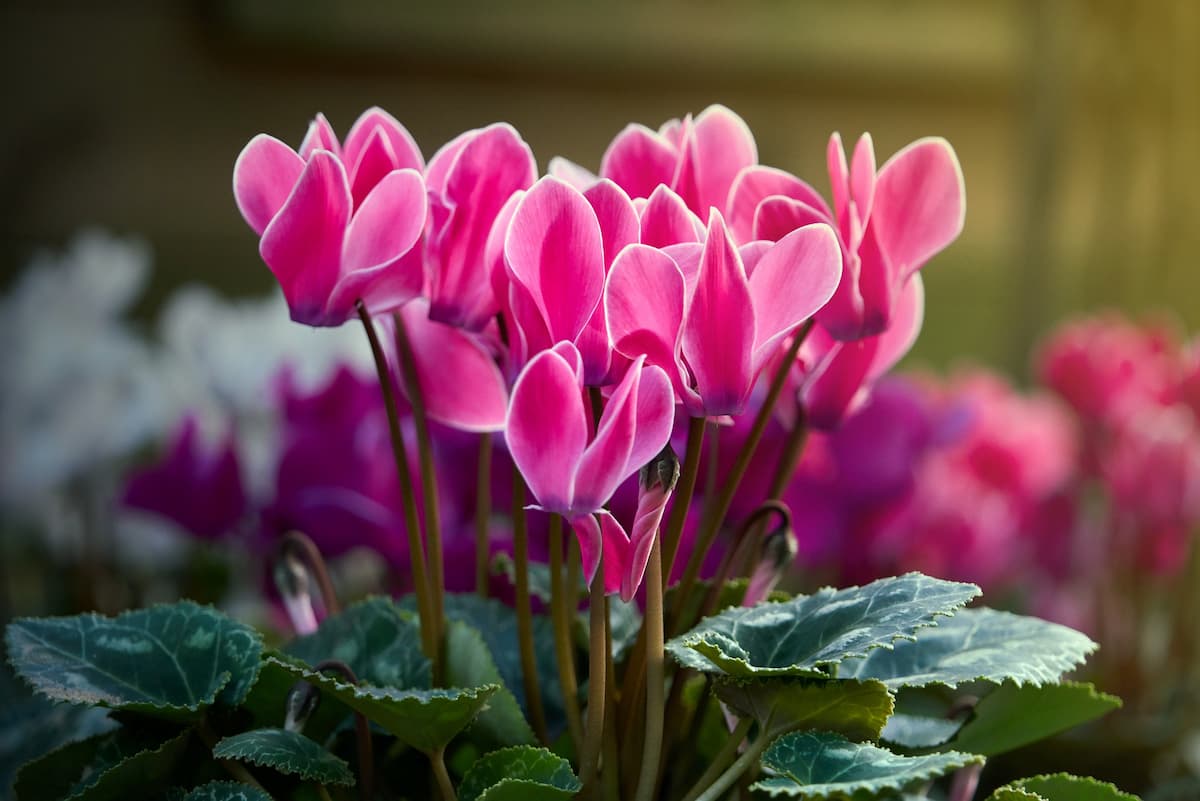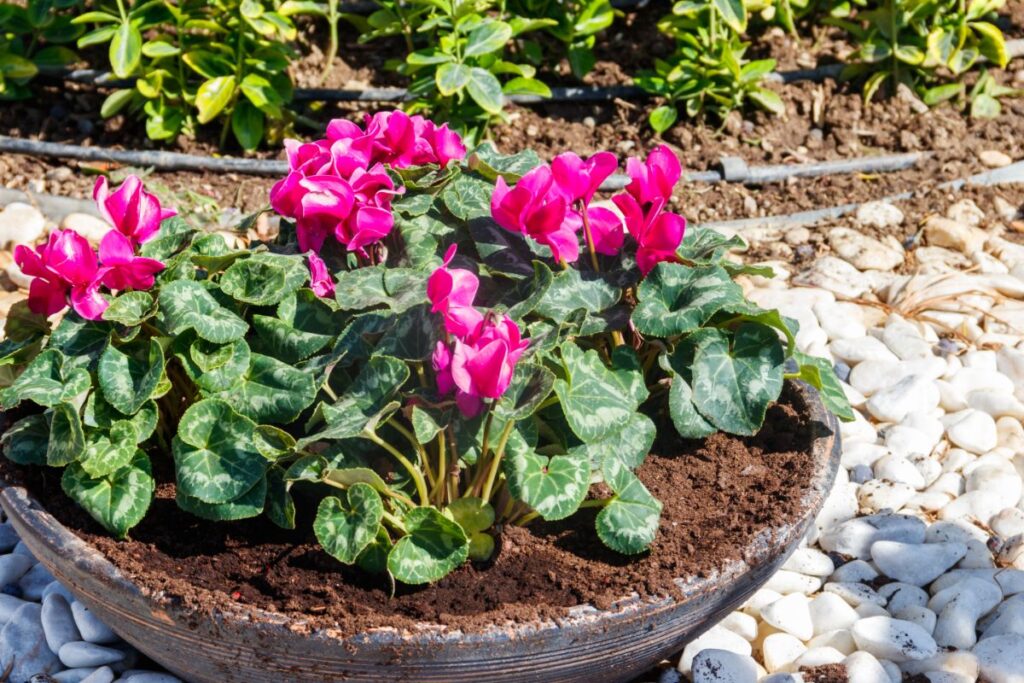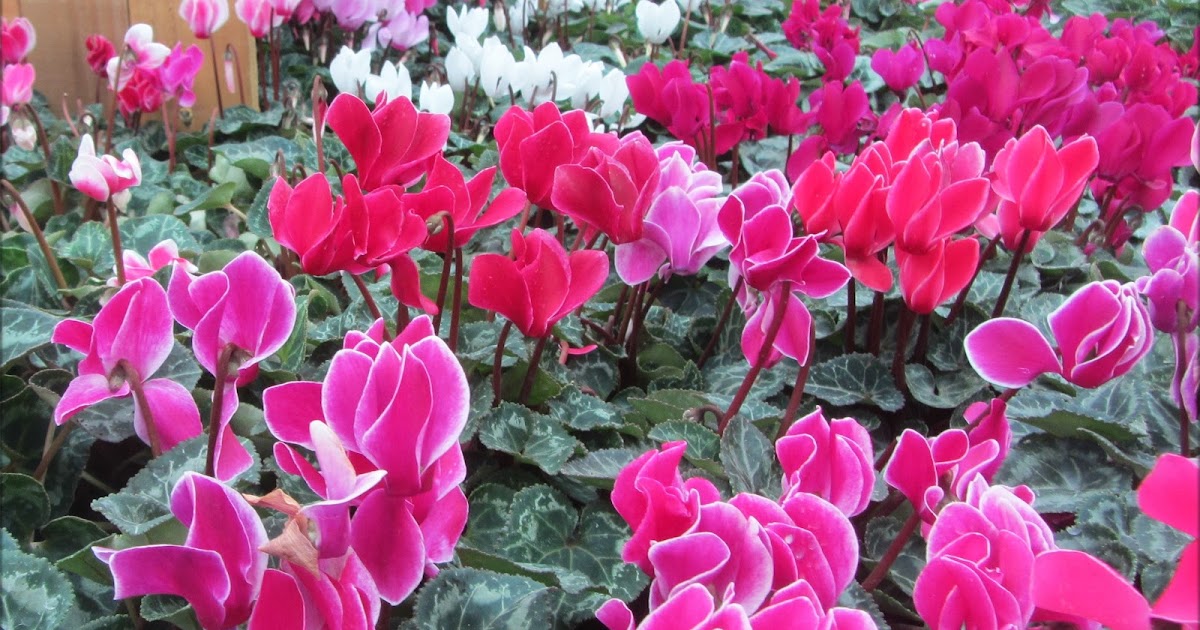Understanding Cyclamen Plant Care: The Basics
Cyclamen plants are often misunderstood as being difficult to care for, but with the right techniques, they can thrive. To provide optimal care for cyclamen, it’s essential to understand their unique characteristics. These delicate flowers require a specific set of conditions to flourish, making them a popular choice for experienced gardeners and indoor plant enthusiasts. When learning how to care for cyclamen, it’s crucial to recognize that they are sensitive to extreme temperatures, overwatering, and poor lighting. By acknowledging these factors, you can create an environment that allows your cyclamen plant to reach its full potential.
Cyclamen plants are native to the Mediterranean region and are adapted to thrive in temperate climates. They have heart-shaped leaves with silver markings and produce delicate, nodding flowers in shades of pink, white, and purple. To care for cyclamen, you’ll need to replicate their natural habitat as closely as possible. This involves providing bright, indirect light, maintaining a consistent temperature, and watering carefully to prevent root rot. By mastering these fundamental care techniques, you’ll be well on your way to becoming a cyclamen expert.
One of the most critical aspects of cyclamen care is understanding their growth cycle. These plants typically bloom in the fall and winter months, followed by a period of dormancy in the spring. During this time, the plant’s energy is focused on re-growing its leaves and roots, rather than producing flowers. By recognizing this cycle, you can adjust your care routine accordingly, providing the necessary nutrients and conditions to support healthy growth and flowering.
With the right care and attention, cyclamen plants can provide a stunning display of color and beauty in your home or garden. By following the guidelines outlined in this article, you’ll be able to create an environment that allows your cyclamen plant to thrive, and enjoy the many benefits that these delicate flowers have to offer.
Lighting and Temperature: Creating an Ideal Environment
When it comes to cyclamen care, providing the right lighting and temperature conditions is crucial for optimal growth and flowering. Cyclamen plants prefer bright, indirect light, but direct sunlight can cause the leaves to become scorched and the flowers to fade. To create an ideal environment, place your cyclamen plant near an east- or west-facing window, or use a sheer curtain to filter the sunlight.
In terms of temperature, cyclamen plants prefer a consistent temperature between 60-70°F (15-21°C) during the day and around 55-65°F (13-18°C) at night. Avoid placing your cyclamen plant near heating or cooling vents, fireplaces, or drafty windows, as sudden temperature fluctuations can cause stress to the plant. By maintaining a stable temperature, you can promote healthy growth and prevent common problems like root rot and leaf drop.
It’s also important to note that cyclamen plants have a natural dormant period during the summer months, when the temperature is typically warmer. During this time, the plant’s energy is focused on re-growing its leaves and roots, rather than producing flowers. By providing a cooler temperature and reduced watering, you can help your cyclamen plant conserve energy and prepare for the next growing season.
When learning how to care for cyclamen, it’s essential to understand the importance of temperature and lighting in promoting healthy growth and flowering. By providing the right conditions, you can create an ideal environment for your cyclamen plant to thrive and enjoy its beautiful flowers for months to come.
Watering Cyclamen: The Art of Moisture Management
Watering is a critical aspect of cyclamen care, and it’s essential to get it right to prevent common problems like root rot and leaf drop. When learning how to care for cyclamen, it’s crucial to understand that these plants prefer moist soil, but not waterlogged. To check the soil moisture, stick your finger into the soil up to the first knuckle. If the soil feels dry, it’s time to water.
Water your cyclamen plant thoroughly, making sure the pot drains well to prevent water from accumulating in the soil. Avoid getting water on the leaves or crown of the plant, as this can cause rot and other problems. Instead, water at the soil level, allowing the plant to absorb the moisture it needs.
Humidity is also an essential factor in cyclamen care. These plants thrive in humid environments, typically between 40-60% relative humidity. To provide the right level of humidity, you can place the pot on a tray filled with water and pebbles or use a humidifier nearby. By maintaining the right level of moisture and humidity, you can help your cyclamen plant stay healthy and thrive.
It’s also important to note that cyclamen plants have different watering needs during different times of the year. During the growing season, when the plant is actively producing flowers and leaves, it will require more frequent watering. However, during the dormant season, when the plant is resting, it will require less water. By adjusting your watering schedule accordingly, you can help your cyclamen plant conserve energy and prepare for the next growing season.
By mastering the art of moisture management, you can provide your cyclamen plant with the right conditions to thrive. Remember to check the soil moisture regularly, avoid overwatering, and provide the right level of humidity to keep your plant happy and healthy.
Fertilizing Cyclamen: Feeding Your Plant for Optimal Growth
Fertilizing is an essential part of cyclamen care, as it provides the necessary nutrients for healthy growth and flowering. When learning how to care for cyclamen, it’s crucial to understand that these plants require a balanced diet of nutrients to thrive. A water-soluble fertilizer is the best option for cyclamen plants, as it allows for easy absorption of nutrients through the leaves and roots.
During the growing season, which typically runs from fall to spring, cyclamen plants require regular fertilization to promote healthy growth and flowering. A balanced fertilizer with a ratio of 20-20-20 (nitrogen-phosphorus-potassium) is ideal for cyclamen plants. Apply the fertilizer at half the recommended strength to avoid burning the roots.
It’s also important to note that cyclamen plants have different fertilization needs during different times of the year. During the dormant season, when the plant is resting, it’s best to avoid fertilizing altogether. This allows the plant to conserve energy and prepare for the next growing season.
Overfertilizing is a common mistake that can harm cyclamen plants. Too much fertilizer can cause the leaves to become scorched and the roots to become burned. To avoid this, start with a small amount of fertilizer and gradually increase the strength as needed.
By providing the right amount of fertilizer at the right time, you can promote healthy growth and flowering in your cyclamen plant. Remember to use a balanced fertilizer, avoid overfertilizing, and adjust your fertilization schedule according to the changing seasons.
Potting and Repotting: Giving Your Cyclamen Room to Grow
Potting and repotting are essential aspects of cyclamen care, as they provide the plant with the necessary room to grow and thrive. When learning how to care for cyclamen, it’s crucial to understand that these plants prefer to be slightly root-bound, meaning the roots should be gently crowded in the pot.
To provide the right environment for your cyclamen plant, use a well-draining potting mix that is specifically designed for indoor plants. Avoid using regular garden soil, as it can compact and prevent proper drainage. A pot that is only slightly larger than the plant’s root system is ideal, as it will prevent the soil from becoming too wet and reduce the risk of root rot.
Repotting is typically necessary in the spring, when the plant has outgrown its container and needs more room to expand. Choose a pot that is only one to two sizes larger pots. To repot your cyclamen plant, gently remove it from its pot and inspect the roots. If the roots are circling or growing out of the
Potting and Repotting: Giving Your Cyclamen Room to Grow
Potting and repotting are essential aspects of cyclamen care, as they provide the plant with the necessary room to grow and thrive. When learning how to care for cyclamen, it’s crucial to understand that these plants prefer to be slightly root-bound, meaning the roots should be gently crowded in the pot.
To provide the right environment for your cyclamen plant, use a well-draining potting mix that is specifically designed for indoor plants. Avoid using regular garden soil, as it can compact and prevent proper drainage. A pot that is only slightly larger than the plant’s root system is ideal, as it will prevent the soil from becoming too wet and reduce the risk of root rot.
Repotting is typically necessary in the spring, when the plant has outgrown its container and needs more room to expand. Choose a pot that is only one to two sizes larger pots. To repot your cyclamen plant, gently remove it from its pot and inspect the roots. If the roots are circling or growing out of the
Potting and Repotting: Giving Your Cyclamen Room to Grow
Potting and repotting are essential aspects of cyclamen care, as they provide the plant with the necessary room to grow and thrive. When learning how to care for cyclamen, it’s crucial to understand that these plants prefer to be slightly root-bound, meaning the roots should be gently crowded in the pot.
To provide the right environment for your cyclamen plant, use a well-draining potting mix that is specifically designed for indoor plants. Avoid using regular garden soil, as it can compact and prevent proper drainage. A pot that is only slightly larger than the plant’s root system is ideal, as it will prevent the soil from becoming too wet and reduce the risk of root rot.
Repotting is typically necessary in the spring, when the plant has outgrown its container and needs more room to expand. Choose a pot that is only one to two sizes larger pots. To repot your cyclamen plant, gently remove it from its pot and inspect the roots. If the roots are circling or growing out of the
Seasonal Care: Adapting to the Changing Seasons
Cyclamen plants require different care during different seasons. To keep your cyclamen plants thriving year-round, it’s essential to adjust their care according to the changing seasons. In the winter, cyclamen plants require a period of dormancy, during which they should be kept in a cool, dark place with minimal watering.
In the spring, cyclamen plants begin to renew their growth, and it’s essential to provide them with more light and water. This is also the best time to repot cyclamen plants, as they will have outgrown their containers and require more room to expand.
During the summer, cyclamen plants require more frequent watering and fertilization to promote healthy growth and flowering. However, it’s essential to avoid overwatering, as this can lead to root rot and other problems.
In the fall, cyclamen plants begin to prepare for their winter dormancy, and it’s essential to reduce watering and fertilization. This will help the plant conserve energy and prepare for the next growing season.
By adjusting cyclamen care according to the changing seasons, you can keep your plants thriving year-round. Remember to provide the right amount of light, water, and fertilization, and to repot your cyclamen plants in the spring when necessary.


:max_bytes(150000):strip_icc()/close-up-of-red-and-pink-mini-cyclamen-in-blue-pots-with-ivy--hedera---and-ragwort--senecio--122005490-5c438917c9e77c0001a2db39.jpg)


:max_bytes(150000):strip_icc()/KaraRiley-2-063fb55e93284068975dac3440431e92.jpg)



